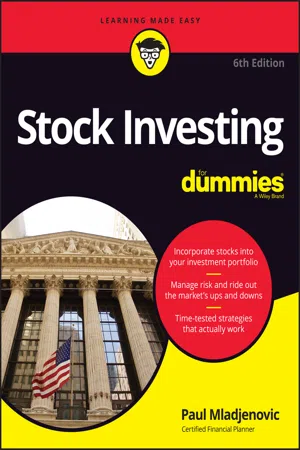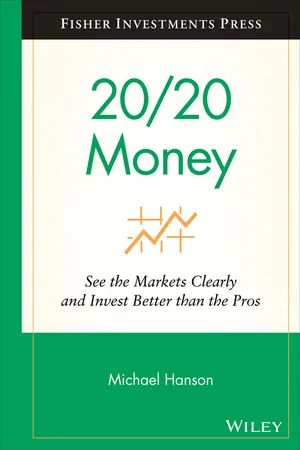Economics
How to Invest in the Stock Market
Investing in the stock market involves purchasing shares of publicly traded companies with the expectation of earning a return on investment. It requires conducting thorough research, understanding market trends, and assessing the financial health of companies before making investment decisions. Diversification and long-term perspective are key strategies for successful stock market investing.
Written by Perlego with AI-assistance
Related key terms
4 Key excerpts on "How to Invest in the Stock Market"
- eBook - ePub
- Todd A. Knoop(Author)
- 2019(Publication Date)
- Greenwood(Publisher)
4 How Do Stocks and Stock Markets Work?In this chapter we will discuss the common features of stocks and how they differ from bonds. We will also talk about how stocks are valued and how differences of opinion among investors regarding risk and return create a resale market for stocks—the stock market. Next, we will talk about how the public follows the rises and falls of the market through the use of stock market indices. This chapter concludes with a discussion about the importance of financial fundamentals in pricing stocks relative to the importance of market psychology. Here we will discuss many of the new insights from behavioral finance, which attempts to explain the ways in which markets have predictable cognitive biases in their decision-making.WHAT IS A STOCK?Call them stocks or shares or equities. Stocks are financial instruments that allow corporations and people to diversify their risks, transfer risk, diversify their wealth, earn higher returns on their wealth, and trade money for long (possibly infinite) periods of time.While stock markets are smaller than bond markets and provide less total finance, the general public follows them much more closely. In part, this is because stocks are somewhat easier to understand and their value is more directly linked to the performance of a firm than bonds are. But stocks are also closely watched because they play a crucial role in gathering and communicating information about our economy; they are a central link between the financial world and the real world. Stock prices tell us about the value of corporations, the value of industries, and the value of our economy as a whole—both today and in the future. Because these valuations rise and fall over time—often quite dramatically—many people see stock markets as something similar to a casino and believe that buying a stock is equivalent to playing roulette. Often lost in the drama of booms and busts in stock prices is the fact that saving your money in the U.S. stock markets over the long term has proven to be one of the most reliable ways to create wealth in human history. Casinos are nowhere near such good bets. - No longer available |Learn more
- Paul Mladjenovic(Author)
- 2020(Publication Date)
- For Dummies(Publisher)
much better than the average investor. Note that patience and discipline count now more than ever.The purpose of this book is not only to tell you about the basics of stock investing but also to let you in on solid strategies that can help you profit from the stock market. Before you invest, you need to understand the fundamentals of stock investing, which I introduce in this chapter. Then I give you an overview of how to put your money where it will count the most.Understanding the Basics
The basics of stock investing are so elementary that few people recognize them. When you lose track of the basics, you lose track of why you invested to begin with. Part 1 of this book helps you grasp these basics:- Knowing the risk and volatility involved: Perhaps the most fundamental (and therefore most important) concept to grasp is the risk you face whenever you put your hard-earned money in an investment such as a stock. Related to risk is the concept of volatility. Volatility refers to a condition in which there is rapid movement in the price of a particular stock (or other security); investors use this term especially when there’s a sudden drop in price in a relatively short period of time. Find out more about risk and volatility in Chapter 4 .
- Assessing your financial situation: You need a firm awareness of your starting point and where you want to go. Chapter 2 helps you take stock of your current financial status and your goals.
- Understanding approaches to investing: You want to approach investing in a way that works best for you. Chapter 3 defines the most common approaches to investing.
- Seeing what exchange-traded funds have to offer: Exchange-traded funds (ETFs) are like mutual funds, but they can be traded like stocks. I think that every stock investor should consider ETFs as a positive addition to their portfolio strategies. See Chapter 5
- H. Kent Baker, John R. Nofsinger, Andrew C. Spieler(Authors)
- 2020(Publication Date)
- Emerald Publishing Limited(Publisher)
2THE STOCK MARKET: OWNING A PIECE OF COMPANIES
“One of the funny things about the stock market is that every time one person buys, another sells, and both think they are astute.” —William Feather, American publisher and author“Owning stocks is like having children. Don’t get involved with more than you can handle.” Peter LynchStock investing isn’t a get-rich-quick scheme. Instead, it should be a rational, disciplined, and systematic process leading to long-term wealth accumulation and the attainment of your financial goals. Before investing in individual stocks, you should put your money into inexpensive index mutual funds or exchange-traded funds (ETFs) that closely follow the US economy as further discussed in Chapter 5 . Why? First, if you only have a small amount of money to invest, you’ll be unable to cost-effectively buy individual stocks and still be diversified. Second, most people, especially novice investors, don’t know how to pick individual stocks.“Most of the time, I don’t know how to pick stocks. It is not an easy game.” Warren BuffettYou also need to understand what stocks are and how they work. Be aware that stock investing involves risk, including the potential loss of your initial investment. There are no guarantees except that markets fluctuate over time. No investment strategy is always right. The best you can hope for is to be right most of the time. Learning how to invest in stocks takes time and effort, but it’s worthwhile because knowledge and experience create wealth opportunities. After becoming familiar with investing basics, you should gradually improve your skills to avoid costly mistakes.If you’re like many investors, owning stocks in some form is likely to be a cornerstone of your investing strategy. For example, roughly half of adult Americans own stocks, either directly through individual stocks or indirectly through mutual funds, ETFs, pensions, or retirement plans. The indirect approach doesn’t require individual stock picking on your part. Although the wealthiest 1% of Americans hold nearly 40% of stocks and the wealthiest 10% of American families hold about 84% of the nation’s stocks, stock ownership is not just for the wealthy. Savvy investors know that having stocks in their portfolios can help them build wealth providing they are willing to bear risk over a sufficient time to weather market declines and reap the rewards of long-term gains.- eBook - ePub
20/20 Money
See the Markets Clearly and Invest Better Than the Pros
- Michael Hanson(Author)
- 2009(Publication Date)
- Wiley(Publisher)
5HOW STOCK MARKETS REALLY WORKPrices are important not because money is considered paramount but because prices are a fast and effective conveyor of information through a vast society in which fragmented knowledge must be coordinated.—Thomas SowellIt is the fundamental wisdom of the capitalist system that it functions irrespective of the wisdom or the stupidity of the capitalists.—Gustav StolperThis chapter won’t give a usual view of how stock markets work. We’re not going to cover the basics of trade, or how the Federal Reserve works, or financial statements, or any of that. Those are fine and great things, but they’re not what this book is about.This chapter provides a way to understand how markets work for investors. Too many folks believe that if you can understand how the economy functions, perfect vision of markets will naturally follow. Nope! Markets and economies are mechanically different beasts, requiring completely different approaches to understand.This book is about how to think about markets and understand them better, but it isn’t to say you can just disregard economic things. It’s important for investors to know how the economy works because otherwise one cannot critique or corroborate other assessments or determine what is relevant and irrelevant for stocks. For guides on how to analyze and understand how sectors of the economy work, I recommend the Fisher Investments On series. Each volume covers a specific sector of the global economy and strategies for stock investing in that sector.We won’t do that here. Instead, we’re looking for a point of view—a new way to think—about how markets function to make us more successful investors. The first thing to do toward that goal is correctly understand how free markets work.CAPITALISM BY ANY OTHER NAME
It’s fascinating how humans pass on knowledge and experience by continually reinventing—we often say the same things over and again but in a slightly new way. It’s typical in academia, but just as prevalent with society generally. Over and over again, variations on the same themes are repackaged to audiences in film, books, and other forms of mass media. (Long before Obi-Wan Kenobi taught Luke Skywalker wisdom about the cosmos, Merlin did it for King Arthur. And Superman couldn’t exist without scads of messianic figures like Jesus and the Buddha to arrive before him.)
Index pages curate the most relevant extracts from our library of academic textbooks. They’ve been created using an in-house natural language model (NLM), each adding context and meaning to key research topics.



